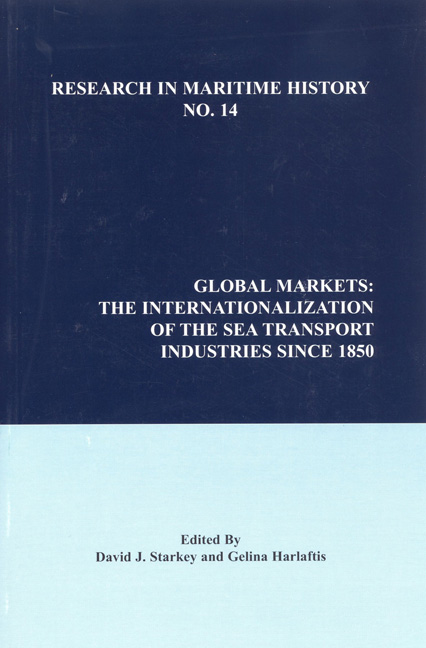Book contents
- Frontmatter
- Contents
- About the Editors
- Contributors
- Introduction
- “International Freight Markets in the 1830s and 1840s: The Experience of a Major Finnish Shipowner”
- “The First (and Very Secret) International Steamship Cartel, 1850-1856”
- “Competition or Co-operation in the Global Shipping Industry: The Origins and Impact of the Conference System for British Shipowners before 1914”
- “National Alliances and Global Webs: The Internationalization of Japanese Shipping”
- “Dutch Sea Transport in Transition: The German Hinterland as Catalyst, 1850-1914”
- “The Expansion of American Interests in Transatlantic Commerce and Trade, 1865-1893”
- “The Expansion of Japan's Shipping Interests before the Sino-Japanese War”
- “Cooperation and Reorganization on the North-South Routes from Japan in the Interwar Period”
- “The Global Communications Industry and Its Impact on International Shipping before 1914”
- “The Nineteenth-Century Roots of Globalization: Some Technological Considerations”
- “The Global Fish Market: Internationalization and Globalization, 1880-1997”
- “Convergence or National Styles? The Japanese Challenge to the British-Norwegian Hegemony in the Twentieth-Century Whaling Industry”
- “International Trends and Greek Shipping: The Business Strategy of Demetrios Moraitis, 1893-1908”
- “Organizational and Managerial Patterns of Greek- Owned Shipping Enterprises and the Internationalization Process from the Internar Period to 1990”
- “Internationalization and the Collapse of British Shipbuilding, 1945-1973”
- “Globalization and International Competitiveness: The Experience of the Japanese Shipping Industry since the 1960s”
- “Containerization and the Globalization of Liner Shipping“
“The Nineteenth-Century Roots of Globalization: Some Technological Considerations”
- Frontmatter
- Contents
- About the Editors
- Contributors
- Introduction
- “International Freight Markets in the 1830s and 1840s: The Experience of a Major Finnish Shipowner”
- “The First (and Very Secret) International Steamship Cartel, 1850-1856”
- “Competition or Co-operation in the Global Shipping Industry: The Origins and Impact of the Conference System for British Shipowners before 1914”
- “National Alliances and Global Webs: The Internationalization of Japanese Shipping”
- “Dutch Sea Transport in Transition: The German Hinterland as Catalyst, 1850-1914”
- “The Expansion of American Interests in Transatlantic Commerce and Trade, 1865-1893”
- “The Expansion of Japan's Shipping Interests before the Sino-Japanese War”
- “Cooperation and Reorganization on the North-South Routes from Japan in the Interwar Period”
- “The Global Communications Industry and Its Impact on International Shipping before 1914”
- “The Nineteenth-Century Roots of Globalization: Some Technological Considerations”
- “The Global Fish Market: Internationalization and Globalization, 1880-1997”
- “Convergence or National Styles? The Japanese Challenge to the British-Norwegian Hegemony in the Twentieth-Century Whaling Industry”
- “International Trends and Greek Shipping: The Business Strategy of Demetrios Moraitis, 1893-1908”
- “Organizational and Managerial Patterns of Greek- Owned Shipping Enterprises and the Internationalization Process from the Internar Period to 1990”
- “Internationalization and the Collapse of British Shipbuilding, 1945-1973”
- “Globalization and International Competitiveness: The Experience of the Japanese Shipping Industry since the 1960s”
- “Containerization and the Globalization of Liner Shipping“
Summary
“Globalization” is a term with almost as many meanings as users. For the purposes of this chapter, globalization is defined simply as that situation in which a particular commodity or class of good is produced in widely different parts of the world and whose financing, marketing and sales are worldwide. Considerations of finance, marketing and sales obviously imply that certain services, as well as goods, should be at least internationally widespread, if not global. Such a state of affairs has a number of pre-requisites, some of which are partly or wholly technological, and which may be roughly divided into considerations of transport, the storage and handling of goods, and communication.
Transport is self-explanatory. Unless supply is geographically very restricted, a global market for a commodity will only exist if the cost of transport forms an insignificant part of the price it can command at its destination. It is widely recognized that technological developments in shipping, particularly the arrival of steam power and iron hull construction, had profound effects in every branch of oceanic trade. This is not new: engineers and naval architects at the time wrote in their professional papers about what they were doing and its importance on the wider stage. An obvious example is Alfred Holt, who was both an engineer and a shipowner: by extending the reach of the steam cargo liner to East Asia he changed, for trading purposes, the shape and size of the world. And he knew in advance that he would. By the turn of the century, the transatlantic passenger traffic was being discussed by such as Kennedy in primarily technological terms, and Kirkaldy, while allotting more importance to commercial and financial factors, still stressed technological development. More recently, Hyde — primarily a business historian — emphasized the importance of Holt's innovations, and particularly his development of the ensemble of a screw-propelled iron hull with a compound steam engine. In conference papers, in journals and in part-works, die transition to steam has continued to fascinate scholars. In 1996, a conference at the University of Hull recognized that fascination, even exploring such novel backwaters as the development of a decisive “technology gap” based on steam and iron which eventually made piracy unprofitable on most trade routes.
- Type
- Chapter
- Information
- Global MarketsThe Internationalization of The Sea Transport Industries Since 1850, pp. 217 - 238Publisher: Liverpool University PressPrint publication year: 1998



